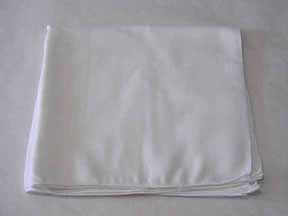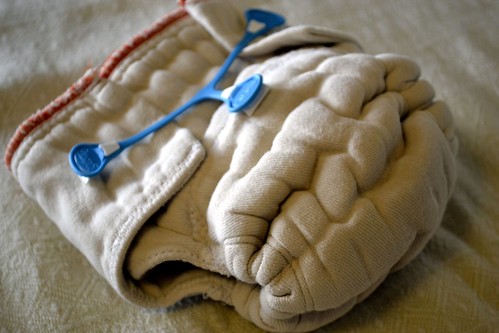I started using cloth diapers when Myles was 4 months old. I wanted to earlier, but allowed people to talk me out of it. I had so many people telling me it was gross, their horrible experiences with it (this from people who used cloth diapers years ago before there were as many amazing options!) and people telling me it would be too much work. I was also overwhelmed with all the cloth diapering information so it took me a while to research and wade through all of it! When we first started, I wanted to find the most economical way to do it and be able to get enough of a diaper stash that I wasn't having to do laundry every day to make it work. We started with 2 of the Flip Diaper System packs and a box of Econobum pre-folds with 3 covers. This gave me 7 covers and 12 inserts (for the Flip) and 12 pre-folds. I ended up only using one of the Econobum covers, to be honest I found them to be flimsy and cheaply made. The one cover I did use, ended up falling apart. However I loved the pre-folds. I wasn't terribly keen on the Flip inserts but loved the Flip covers so I used those and the pre-folds. Pre-folds really work well when your baby is EBF (exclusively breast fed) and their stools tend to be really loose. Using pre-folds with the covers, we didn't encounter any of those nasty "Blow-out" diapers that you hear of! We did however deal with those when he was in disposables so for this reason alone I wish we'd cloth diapered from the beginning! Somewhere in the next few months I learned of Hyneacart and of WAHM made diapers (work at home mother) and thus began a re-vamping of my cloth stash! I ended up selling the Flip & Econobum diapers once I got enough other ones. I personally do not buy used (just like I don't buy used underwear for myself!) but a lot of people do, so you can usually sell diapers you end up not being as fond of and re-couping a bit of what you spent. I wish we cloth diapered full time, but we do use disposables at night as Myles is a really heavy wetter and I haven't found a good nighttime solution. Diaper brands we own are:
PLUMP
Cloth Reverie
Doodle Dypes
Licorice Lane
Bebe Britches (sadly she is no longer in business)
Monkey and Bug (currently not making diapers, after having a second set of twins)
Thirsties
Bum Genius
The top 6 links are WAHM's. The bottom 2 are commercial brands.
Now for cleaning information! When Myles was EBF we just threw the whole diaper in the wet bag (We have a Planet Wise hanging bag that we hang on the door of his room, it has a zippered top and keeps smells in so much better then the diaper champ we have for disposables which we do use at night). Now that he is not breast fed and is on solids we just shake off waste into the toilet, then throw the diapers into the wet bag till laundry time. They do make diaper sprayers that you can attach to your toilet and spray off the diapers with that, but we've never really had issues without it. It sounds disgusting, I know but its just as simple to scrape any stubborn waste off with a wipe into the toilet. I figure I am already wiping Myles off so it isn't really any different. I try to wash at least 2 times a week. Letting them sit any longer you can end up with stink or stain issues. For washing you will need to use a cloth diaper friendly detergent. If you don't you can end up with repelling issues (shedding water, which of course you don't want!). I use either Rockin' Green detergent or Eco Nuts on our cloth diapers. To wash I open the wet bag over the washer & dump the diapers in and the bag. I run a cold rinse cycle, then add detergent and do a hot wash that is followed by a cold rinse (it is a function on my washer). Then I dry on high. Wool dryer balls are great to add to your dry cycle for speeding up drying time. Also don't use dryer sheets! The additives can cause issues with your diapers absorbancy! Fold and ready to go!
A few additional notes: With cloth diapers you will need to use a cloth diaper friendly rash cream if your child has a rash. Myles seldom gets rashes unless he is teething or sick but when he does we use Grovia Magic stick rash ointment. Mother Love also makes a good rash ointment. If he has a really bad rash and I want to use something stronger, I will either use a disposable or lay something on top of the cloth diaper like a small piece of flannel or fleece to act as a buffer. Typical rash creams can coat the diaper and make them repel.
Some diaper styles & terms (taken from Cuties with Cloth Booties on Cafemom):
Cloth Diaper Types
Flat: A single layered fabric (typically cotton) that can be folded where absorbency is needed most, or simply folded into a square and used like a prefold. Cotton weaves include birdseye, muslin. Economical and one sized (can be doubled when baby is older). Receiving blankets can be used (but need to be pinned). You need a cover to make this type of diaper waterproof.


Prefold: A flat, layered, rectangular diaper with extra layers for absorbency in the center. Commonly used with a fastener and waterproof cover. Economical to buy and can be re-purposed as burp/cleaning cloths or inserts/doublers. Great for the newborn stage. You need a cover to make this type of diaper waterproof.

Pre-Fitted: A fitted diaper made from a prefold. Goes on like a disposable. May have snaps or aplix (a.k.a. velcro, hook and loop, touchtape) closure, or require pins or a Snappi. You need a cover to make this type of diaper waterproof.

Fitted: A shaped diaper that includes elasticized legs. Most commonly has an aplix or snap closure. You need a cover to make this type of diaper waterproof.

Contour: Shaped, like a fitted diaper, but without elastic and usually without attached closures. Commonly used with pins or a Snappi. You need a cover to make this type of diaper waterproof.

Pocket: A 2 layered diaper that requires the addition of an absorbent insert. The outer layer is most commonly made of PUL, with the inner (the part that sits against baby's skin) usually being a "stay-dry" fabric (microfleece, suedecloth, etc.) that allows moisture to seep through to the insert, keeping baby's skin dry. Use a fresh, clean insertand pocket at each change. You do NOT need a cover to make this type of diaper waterproof.

All In One (AIO): The closest option to disposable diapers. Outside is made of a waterproof layer, and the absorbency is sewn in. You do NOT need a cover to make this type of diaper waterproof.

All In Two (AI2): Similar to an AIO, but with a removable absorbent layer for easier washing and faster drying. Absorbent layer is usually snapped in place inside the diaper, sitting directly against baby's skin. You do NOT need a cover to make this type of diaper waterproof.


Hybrid Diapers: These diapers feature a waterproof shell and different types of lay-in inserts that allow you to just replace the insert and continue using the shell. The different inserts may include disposable inserts, microfiber inserts, and some people even reuse trifolded prefolds as inserts.

Covers
Polyurethane Laminate (PUL): The waterproof fabric commonly used for making diapers and diaper covers. PUL covers can be air dried and reused in a day's rotation unless soiled with poo. 3-6 covers are usually adequate for a full diapering stash.
Nylon: Not as commonly used as PUL, but a popular economical alternative. Usually found in a pull-on style cover
Wool (Soakers, Shorties, Longies, Skirties): Wool yarn can be used to knit or crochet diaper covers that, once treated with lanolin, are quite waterproof. Wool covers also offer breathability that PUL covers do not, as well as certain antimicrobial properties.
Interlock (Soakers, Shorties, Longies, Skirties): Wool or acrylic yarn that has been tightly woven into more of a fabric than knitting or crocheting produces.
Acrylic (Soakers, Shorties, Longies, Skirties): Like wool, but made with acrylic yarn. Can be washed more often and washed/dried with your normal laundry.
Fleece (Soakers, Shorties, Longies, Skirties): A synthetic alternative to wool, fleece can be used as a diaper cover.
Soaker: A term for a diaper cover made of wool, acrylic, or fleece, most commonly in the form of a pull-on (rather than wrap w/ aplix or snap closure).
Accessories
Pins: Special safety pins used to fasten certain types of diapers.
Snappi: An alternative to pins. 2-3 is usually adequate for a full diapering stash.
Aplix, Touchtape: Velcro
Liners: Piece of fabric or paper that is laid into a diaper to protect the diaper from creams, make removal of poo easier, or provide a "stay-dry" feeling on baby's skin. Most of the paper liners on the market are flushable. Fleece liners are easily and cheaply made by cutting synthetic fabric store microfleece into rectangles.
Inserts: Separate absorbent layers for use inside pocket diapers.
Doublers: Extra (usually smaller) inserts for use in combination with primary inserts.
Soaker: Another term for the absorbent layer of any diaper.
Polyurethane Laminate (PUL): The waterproof fabric commonly used for making diapers and diaper covers. PUL covers can be air dried and reused in a day's rotation unless soiled with poo. 3-6 covers are usually adequate for a full diapering stash.
Nylon: Not as commonly used as PUL, but a popular economical alternative. Usually found in a pull-on style cover
Wool (Soakers, Shorties, Longies, Skirties): Wool yarn can be used to knit or crochet diaper covers that, once treated with lanolin, are quite waterproof. Wool covers also offer breathability that PUL covers do not, as well as certain antimicrobial properties.
Interlock (Soakers, Shorties, Longies, Skirties): Wool or acrylic yarn that has been tightly woven into more of a fabric than knitting or crocheting produces.
Acrylic (Soakers, Shorties, Longies, Skirties): Like wool, but made with acrylic yarn. Can be washed more often and washed/dried with your normal laundry.
Fleece (Soakers, Shorties, Longies, Skirties): A synthetic alternative to wool, fleece can be used as a diaper cover.
Soaker: A term for a diaper cover made of wool, acrylic, or fleece, most commonly in the form of a pull-on (rather than wrap w/ aplix or snap closure).
Accessories
Pins: Special safety pins used to fasten certain types of diapers.
Snappi: An alternative to pins. 2-3 is usually adequate for a full diapering stash.
Aplix, Touchtape: Velcro
Liners: Piece of fabric or paper that is laid into a diaper to protect the diaper from creams, make removal of poo easier, or provide a "stay-dry" feeling on baby's skin. Most of the paper liners on the market are flushable. Fleece liners are easily and cheaply made by cutting synthetic fabric store microfleece into rectangles.
Inserts: Separate absorbent layers for use inside pocket diapers.
Doublers: Extra (usually smaller) inserts for use in combination with primary inserts.
Soaker: Another term for the absorbent layer of any diaper.
No comments:
Post a Comment